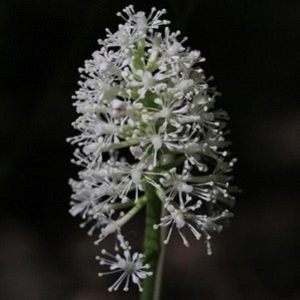There are two flowering modes in Actaea asiatica (Ranunculaceae). In the first mode, the sepals are caducous and the anthers are physically isolated from the stigmas as in most out-breeding, bisexual species in this genus. The second flowering mode leads to mechanical self-pollination (autogamy). The sepals do not open or fall off from the flower, but are only dletached from the floral receptacle. The staminal filaments elongate to push the anthers in between the stigma and the withered sepals. The latter press the dehiscent anthers onto the large stigma, which results in mechanical autogamy. The results of our bagging tests showed that the highest seed set resulted from spontaneous self-pollination in A. asiatica, but no seed set was found as a result of apomixis or anemophily (via air currents). This species is obviously self-compatible and obligate autogamy.
Xianhua Tian
,
Yi Ren
,
Lin Wang
,
Jie Sui
,
Jiudong Zhang
. Self-pollination Mechanism of Actaea asiatica (Ranunculaceae)[J]. Chinese Bulletin of Botany, 2018
, 53(2)
: 212
-218
.
DOI: 10.11983/CBB17086
Aarssen LW (2000). Why are most selfers annuals? A new hypothesis for the fitness benefit of selfing. Oikos 89, 606-612.
Arroyo MTK,Armesto JJ, Primack RB (1985). Community studies in pollination ecology in the high temperate Andes of central Chile II. Effect of temperature on visitation rates and pollination possibilities. Plant systematics and evolution 149, 187-203.
Bake HG (1955). Self-compatibility and establishment after' long-distance' dispersal. Evolution 9, 347-349.
Barrett SC (1998). The evolution of mating strategies in flowering plants.Trends in Plant Science 3, 335-341.
Barrett SCH (2002). Sexual interference of the floral kind. Heredity 88, 154-159.
Barrett, SC,Harder LD (1996). Ecology and evolution of plant mating.Trends in Ecology & Evolution, 11(2), 73-79.
Bodbyl Roels SA, Kelly JK, (2011). Rapid evolution caused by pollinator loss in Mimulus guttatus. Evolution 65, 2541-2552.
Cruden RW (1977). Pollen-ovule ratios: a conservative indicator of breeding systems in flowering plants. Evolution, 32-46.
Dafni, A (1992). Pollination ecology: a practical approach. Oxford University Press.
Darwin, C (1862). On the Two Forms, or Dimorphic Condition, in the Species of Primula, and on their remarkable Sexual Relations. Journal of the Proceedings of the Linnean Society of London. Botany 6, 77-96.
Darwin, C (1876). The effects of cross and self fertilisation in the vegetable kingdom. John Murray. 471-482
Darwin, C (1877). The different forms of flowers on plants of the same species. John Murray.
Daumann E (1969). Zur Blütenmorphologie und Best?ubungs?kologie einiger Ranunculaceae (Cimicifuga L., Actaea L., Thalictrum L.). Preslia 41, 213-219.
Holsinger KE (1996). Pollination biology and the evolution of mating systems in flowering plants. Evolutionary biology (USA).
Holsinger KE (2000). Reproductive systems and evolution in vascular plants. Proceedings of the National Academy of Sciences 97, 7037-7042.
Jain SK (1976). The evolution of inbreeding in plants. Annual Review of Ecology and Systematics 7, 469-495.
Jarne P, Charlesworth D (1993). The evolution of the selfing rate in functionally hermaphrodite plants and animals. Annual Review of Ecology and Systematics 24, 441-466.
Kalisz S, Vogler D, Fails B, Finer M, Shepard E, Herman T, Gonzales R (1999). The mechanism of delayed selfing in Collinsia verna (Scrophulariaceae). American Journal of Botany 86, 1239-1247.
Kalisz S, Vogler DW (2003). Benefits of autonomous selfing under unpredictable pollinator environments. Ecology 84, 2928-2942.
Lloyd DG (1979). Some reproductive factors affecting the selection of self-fertilization in plants. The American Naturalist 113, 67-79.
Lyon DL (1992). Bee pollination of facultatively xenogamous Sanguinaria canadensis L. Bulletin of the Torrey Botanical Club, 368-375.
Motten AF (1982). Autogamy and competition for pollinators in Hepatica americana (Ranunculaceae). American Journal of Botany, 1296-1305.
Pellmyr O (1984). The pollination ecology of Actaea spicata (Ranunculaceae). Nordic journal of botany 4, 443-456.
Pellmyr O (1985). The pollination biology of Actaea pachypoda and A. rubra (including A. erythrocarpa) in northern Michigan and Finland. Bulletin of the Torrey Botanical Club, 265-273.
Preston RE (1986). Pollen-ovule ratios in the Cruciferae. American Journal of Botany, 1732-1740.
Ruan C, Jiang G (2005). Adaptive significance of herkogamy and floral behaviour. Acta Phytoecological Sinica 30, 210-220.
Ruan C, Qin P, Han R (2005). Strategies of delayed self-pollination in Kosteletzkya virginica. Chinese Science Bulletin 50, 94-96.
Stebbins GL (1957). Self fertilization and population variability in the higher plants. The American Naturalist 91, 337-354.
Traveset A, Willson MF, Sabag C (1998). Effect of nectar‐robbing birds on fruit set of Fuchsia magellanica in Tierra Del Fuego: a disrupted mutualism. Functional Ecology 12, 459-464.
Vogler DW, Kalisz S (2001). Sex among the flowers: the distribution of plant mating systems. Evolution 55, 202-204.


